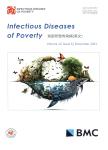Effect of temperature on the—system
作者机构:SchoolofNursingandPublicHealth CollegeofHealthSciences HowardCollegeCampus UniversityofKwaZulu-Natal Durban SouthAfricaSchoolofNursingandPublicHealth SouthAfricaSchoolofLifeSciences CollegeofAgriculture EngineeringandScience WestvilleCampus SouthAfric
出 版 物:《贫困所致传染病(英文)》 (Infectious Diseases of Poverty)
年 卷 期:2017年第3期
页 面:35-41页
学科分类:05[文学]
主 题:Bulinus globosus Cercariae Development rate Fecundity Schistosomiasis Schistosoma haematobium Temperature
摘 要:Background: Given that increase in temperature may alter host-parasite relationships, the anticipated rise in temperature due to global warming might change transmission patterns of certain diseases. However, the extent to which this will happen is not well ***: Using a host-parasite system involvingBulinus globosus andSchistosoma haematobium, we assessed the effect of temperature on snail fecundity, growth, survival and parasite development under laboratory ***: Our results show that temperature may have a non-linear effect on snail fecundity and snail growth. Snails maintained at 15.5 °C and 36.0 °C did not produce egg masses while those maintained at 25.8 °C laid 344 and 105more egg masses than snails at 31.0 °C and 21.2 °C, respectively. Attainment of patency led to a reduction in egg mass production among the snails. However, the reduction in fecundity for snails maintained at 21.2 °C occurred before snails started shedding cercariae. Parasite development was accelerated at high temperatures with snails maintained at 31.0 °C reaching patency after three weeks. Furthermore, snail growth rate was highest at 25.8 °C while it was inhibited at 15.5 °C and reduced at 31.0 °C. Increase in temperature increased snail mortality rates. Snails maintained at 36.0 °C had the shortest survival time while those maintained at 15.5 °C had the longest survival ***: We concluded that temperature influences fecunxdity, growth, survival and parasite development in the snail and thus dictates the time it takes the parasite to complete the life cycle. This has implications on transmission of schistosomiasis in the context of global warming.



